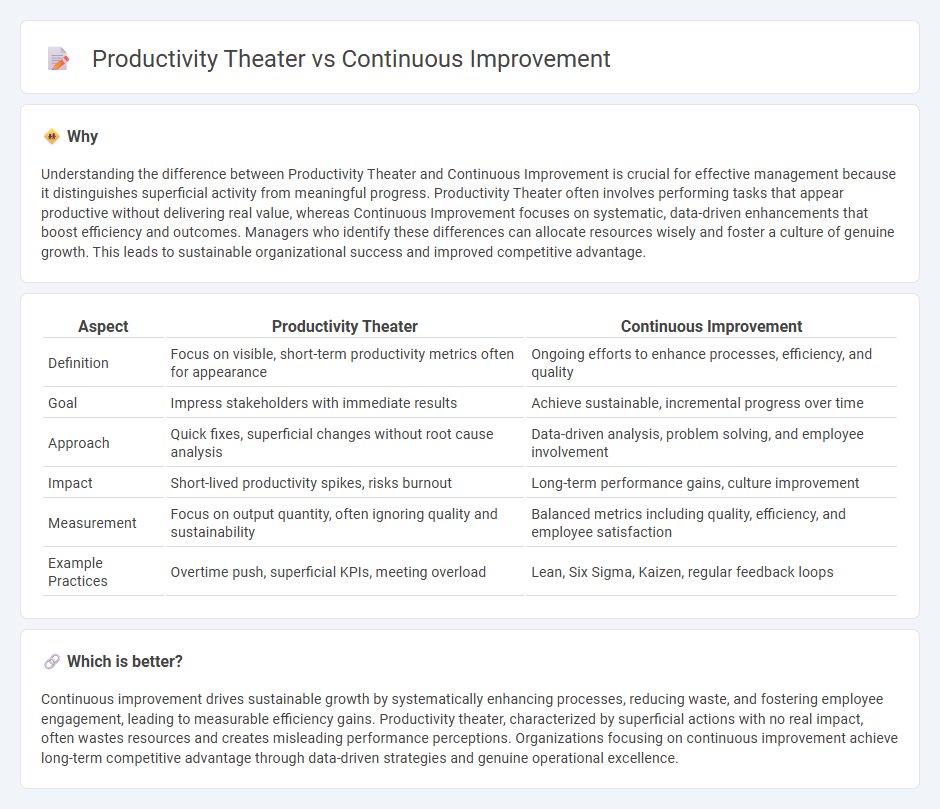
Productivity theater refers to superficial efforts that create the illusion of progress without yielding substantial results, often emphasizing visible activity over meaningful outcomes. Continuous improvement involves systematic, incremental enhancements focused on optimizing processes and achieving lasting performance gains through data-driven analysis and employee engagement. Explore how organizations can shift from mere productivity theater to sustainable growth through continuous improvement strategies.
Why it is important
Understanding the difference between Productivity Theater and Continuous Improvement is crucial for effective management because it distinguishes superficial activity from meaningful progress. Productivity Theater often involves performing tasks that appear productive without delivering real value, whereas Continuous Improvement focuses on systematic, data-driven enhancements that boost efficiency and outcomes. Managers who identify these differences can allocate resources wisely and foster a culture of genuine growth. This leads to sustainable organizational success and improved competitive advantage.
Comparison Table
| Aspect | Productivity Theater | Continuous Improvement |
|---|---|---|
| Definition | Focus on visible, short-term productivity metrics often for appearance | Ongoing efforts to enhance processes, efficiency, and quality |
| Goal | Impress stakeholders with immediate results | Achieve sustainable, incremental progress over time |
| Approach | Quick fixes, superficial changes without root cause analysis | Data-driven analysis, problem solving, and employee involvement |
| Impact | Short-lived productivity spikes, risks burnout | Long-term performance gains, culture improvement |
| Measurement | Focus on output quantity, often ignoring quality and sustainability | Balanced metrics including quality, efficiency, and employee satisfaction |
| Example Practices | Overtime push, superficial KPIs, meeting overload | Lean, Six Sigma, Kaizen, regular feedback loops |
Which is better?
Continuous improvement drives sustainable growth by systematically enhancing processes, reducing waste, and fostering employee engagement, leading to measurable efficiency gains. Productivity theater, characterized by superficial actions with no real impact, often wastes resources and creates misleading performance perceptions. Organizations focusing on continuous improvement achieve long-term competitive advantage through data-driven strategies and genuine operational excellence.
Connection
Productivity theater, the appearance of busy work without real value, hinders true efficiency by masking underlying issues in workflows. Continuous improvement focuses on systematically identifying and eliminating waste, fostering genuine productivity gains in management processes. Effective management aligns continuous improvement initiatives with measurable outcomes to avoid productivity theater and drive sustainable organizational growth.
Key Terms
Kaizen
Kaizen, a Japanese philosophy emphasizing continuous, incremental improvements, drives tangible productivity gains by fostering employee involvement and systematic problem-solving. Unlike productivity theater, which prioritizes superficial metrics and appearances, Kaizen integrates real workflow optimizations that enhance efficiency and quality over time. Explore how Kaizen can transform organizational culture and operational performance for sustained success.
Key Performance Indicators (KPIs)
Continuous improvement drives sustainable growth by consistently refining processes and enhancing efficiency, directly impacting Key Performance Indicators (KPIs) such as cycle time, defect rates, and customer satisfaction. Productivity theater, on the other hand, often emphasizes superficial metrics and short-term outputs without delivering true operational gains or meaningful KPI improvements. Explore effective strategies to accurately measure and boost real productivity through targeted KPI analysis.
Value-Added Activities
Continuous improvement emphasizes systematic enhancements targeting value-added activities that directly contribute to business goals and customer satisfaction, driving sustainable productivity gains. In contrast, productivity theater often involves superficial metrics and busywork that create an illusion of progress without delivering meaningful results. Explore effective strategies to distinguish genuine value-driven improvements from mere activity illusions.
Source and External Links
Continual improvement process - Wikipedia - A continual improvement process (also called continuous improvement) is an ongoing effort to improve products, services, or processes incrementally or through breakthrough advances, focusing on feedback, efficiency, and evolutionary steps to enhance organizational effectiveness.
Continuous Improvement Model - ASQ - Continuous improvement is the ongoing enhancement of products, services, or processes often implemented via the PDCA (Plan-Do-Check-Act) cycle, emphasizing incremental or breakthrough improvements and involving methods like Six Sigma and lean management.
What Is Continuous Improvement? (With 13 Examples) | Indeed.com - Continuous improvement is a business strategy that systematically evaluates and revises processes and practices with practical examples including employee performance reviews, simplifying purchasing methods, improving health and safety, and managing potential risks to drive ongoing organizational growth.
 dowidth.com
dowidth.com